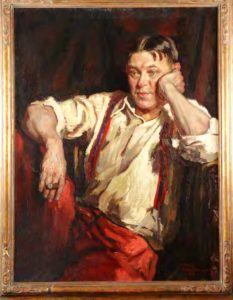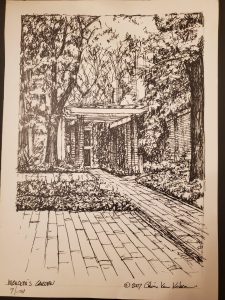The Mencken House
Of the four children, Henry Louis, Charles Edward, August Jr., and Anna Gertrude, it was Henry Louis Mencken, the “Sage of Baltimore”, who made this residence famous. It has been said that at the height of his career, one could address a letter to H. L. Mencken, Baltimore, and be assured that the Post Office would deliver it to his Hollins Street address. With the exception of a five year period when he lived in an apartment at 704 Cathedral Street during his marriage to Sarah Powell Haardt, Mencken lived in his Hollins Street house until his death in 1956 at age 76. In 1926, he wrote “I have lived in one house in Baltimore for nearly 45 years. It has changed in that time, as I have but somehow it still remains the same. No conceivable decorator’s masterpiece could give me the same ease. It is as much a part of me as my own 2 hands. If I had to leave it, I’d be as certainly crippled as if I had lost a leg.”
The city owned Victorian residence is a well preserved example of row house life of a prosperous family in the late 19th and 20th centuries. It includes changes made in the 1920s, among them the installation of parquet floors on all 3 levels, an indication of the prosperity of the Menckens, and the removal of the ornate fireplace mantel in the front parlor, after a central heating system was installed. But much more than that, the Mencken House can be considered among the nation’s most significant house museums associated with an American man of letters. Thanks to his autobiographical writings: Happy Days, Newspaper Days, and Heathen Days, we know much about Henry’s life in this house. It is here where the novelist and screenwriter James Cain remembers Mencken ready at the door to greet him with a shaker of martinis – and where pictures of Mencken’s paternal German ancestors were proudly displayed in the front hallway. The first floor front parlor, which appears as a typical 19th century room for entertaining, was one of the meeting places of the “Saturday Night Club” members, a group of Mencken’s friends who made music, talked and enjoyed beer. The sitting room, or middle parlor, was the focus of family life, where Mencken liked to relax in his chair and receive his friends, F. Scott Fitzgerald among many. Much of Mencken’s writing was done in the second floor front study. In that room, surrounded by his books and typewriter, couch and comfortable chairs, and with a direct view of the park and neighborhood that he loved, Mencken conceived and wrote many of his critically acclaimed works. In that room, surrounded by his books and typewriter, Mencken edited the books of Theodore Dreiser and suggested the works of African American writers to his publisher, Alfred Knopf. Here is where Mencken wrote the newspaper columns and books that made him, in the words of Walter Lippman, “the most powerful personal influence in America”, celebrated for the wit and humor that many have compared to Mark Twain.
The Mencken House garden was a land of enchantments that was the setting for numerous escapades when he was a boy. In the back of the yard was a stable, where he and his brother kept a pet pony named Frank, who once put his head through the open dining room window to slurp on a bowl of homemade ice cream sitting on the window sill.
As Mencken grew older he made the garden his own, replacing the wooden fence on the west side with a brick wall embedded with ornamental tiles, a small fountain with an angel head, a cast stone death mask of one of his favorite composers, Ludwig van Beethoven, complete with the first few notes of his 5th symphony, and a grave marker for his dog Tessie. The current gazebo used to be a “summer house” with enclosed walls. After Mencken’s stroke in 1948, the garden was a comforting refuge, a place to smoke a cigar and look at the stars.
In 1983, the Baltimore City government, under the leadership of Mayor William Donald Schaefer and Walter Sondheim, acquired the house from the University of Maryland for the purpose of its preservation and open it as a museum, under the stewardship of the “Baltimore City Life Museums” organization. Unfortunately, due to financial problems, the museum closed in 1997 and was subsequently shuttered for 22 years. Thanks to a generous bequest by former Mencken Society member Navy Commander Max Edwin Hency, the house has since then undergone a $1.3 million dollar renovation and reopened to the public in the fall of 2019. Based on meticulous research and photo documentation, the Society to Preserve H. L. Mencken’s Legacy planned and facilitated the return of most of the antique furnishings and artifacts from their two-decade long storage to the house after the renovation was completed. The restored and refurbished house is shown today as it appeared in 1940.




